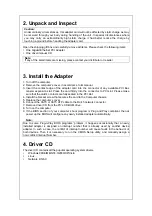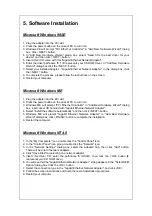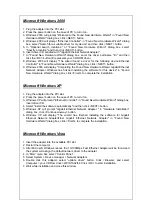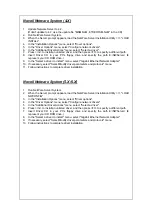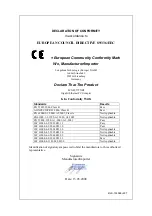
1. Introduction
Thanks for the purchasing of your new Gigabit Ethernet PCI adapter. This document
describes the Installation of network adapter. This adapter supports 10BASE-T, 100BASE-TX
and 1000BASE-T Ethernet copper interface. Moreover, the PCI interface on the Gigabit
Ethernet NIC complies with PCI Local Bus, is compatible with 32-bit PCI bus. As a bus master,
the NIC requests access to the PCI bus, instead of waiting to be polled.
1.1 Features
The Gigabit Ethernet PCI adapter is a cost effective, high-performance network interface card.
It operates in 10BASE-T, 100BASE-TX and 1000BASE-T modes and integrates easily with
Fast Ethernet hub and Gigabit hub and switch.
y
Complies with IEEE 802.3 10BASE-T standard
y
Complies with IEEE 802.3u 100BASE-TX standard
y
Complies with IEEE 802.3ab 1000BASE-T standard
y
Complies with PCI specifications
y
Supports 32 bit bus master for high throughput and low CPU utilization
y
Supports both half and full duplex operation
y
Supports 10/100/1000Mbps auto-sensing capability
y
Supports Wake-On-LAN (depend on model and user’s motherboard function)
y
Rich diagnostic LED mounted on bracket for easily viewing and troubleshooting (Link/Act
Green/Blinking Green).
y
Plug and Play Installation.
y
Network drivers on CD for Windows 98SE, NT4.0, 2000, XP, Vista, ME, Netware 4/5/6.X,
and Linux driver.
y
FCC, CE class B certification
1.2 System Requirements
To use the adapter, you need the following components:
y
One 32 or 64 bit PCI master mode expansion slot that is compliant with PCI bus
specifications
y
One CD-ROM drive
y
The following cables:
Port Type
Media
Max. Distance
10BASE-T
Cat. 3, 4, or 5 UTP
100 meter
100BASE-TX
Cat. 5 or 5e UTP
100 meter
1000BASE-T
Cat. 5 or 5e UTP
100 meter
NOTE:
1000BASE-T signaling requires four twisted pairs of Category 5 balanced cabling, as
specified in ISO/IEC 11801:1995 and ANSI/EIA/TIA-568-A (1995) and tested for
additional performance using testing procedures defined in TIA/EIA TSB95



